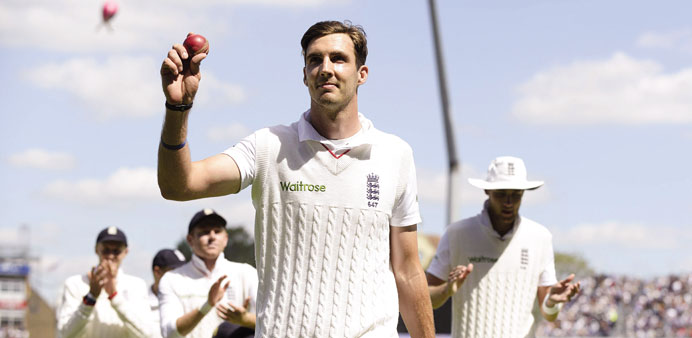England’s Steven Finn leads his team-mates after their win over Australia in the third Ashes Test at Edgbaston. (Reuters)
By Vic Marks/theguardian.com
There is a smile on the face of every English cricket fan this weekend, but it is mingled with bewilderment rather an absolute confidence that the Ashes campaign is under control. We just cannot tell what is going to happen next. If this were a five-set tennis match the score would currently read something like 6-1, 0-6, 6-1. If it were a five-act play, we might grumble that it lacked any credibility.
After the win in Cardiff, England imploded at Lord’s. Trevor Bayliss, who has been living up to his reputation for calmness during this topsy-turvy series, hinted that England concentrated too much on how Australia might react to defeat in Wales. This time Bayliss does, at least, have a few more concerns with his own team to keep him preoccupied.
The mantra of never changing a winning side has never made much sense to me and in any case this will not be possible at Trent Bridge. England have had to replace Jimmy Anderson in the knowledge that there is not a like-for-like replacement available. The decision of who makes the final XI will probably rest in the hands of the medics as much as the selectors.
If they are convinced that Mark Wood is 100% fit then he will surely take Anderson’s place in the side (well, it improves the batting slightly).
Wood would probably have played at Edgbaston if deemed fully fit (thank heavens for his dodgy ankle). He should play at Trent Bridge, with Liam Plunkett and Mark Footitt standing by. This was the course England took in 2009 during the Ashes fervour/panic outside the camp as the final Test approached.
Which batsman should be called up for The Oval? Should there be a dramatic SOS for Mark Ramprakash, Marcus Trescothick or Rob Key? No, the next cab off the rank, which happened to be Jonathan Trott, was the response. That worked OK. Likewise, the England camp has faith in Wood.
There may be more doubts about Adam Lyth at the top of the order. He has 72 runs in six innings. Here, there is another parallel with the 2009 series when Ravi Bopara was tossed into the No3 slot. He played four Tests, scoring in 105 runs in seven innings, before being dropped for The Oval. By then it was obvious, probably even to Bopara, that he had to go. If nothing else a look into his eyes betrayed that he was a spent force in that series. Any spark had long since disappeared.
The impression from a distance is that Lyth is still up for the challenge. Those in the dressing room will have a better idea. He does not seem a tortured soul, prone to agonising about his lot in life. Like Wood he looks as if he is enjoying Test cricket except when Steven Finn is treading on his toes when celebrating his first wicket at Edgbaston.
However, Lyth is also discovering more about the gulf between county and Test cricket and no doubt the Australia slip cordon are reminding him of this at regular intervals.
His survival owes as much to the lack of convincing alternatives as any determination to keep a winning side together.
Moeen Ali is batting with invaluable freedom down the order and he should not be promoted any more than one slot up it.
The one trap England will surely avoid is to contemplate the advantages of a draw given the way the series stands. If fine weather is around the draw seems to have disappeared from the equation in this series. At Lord’s there was a featherbed pitch and yet the match did not reach the fifth day. Australia’s bowlers, imbued with confidence by the size of their first-innings total, were able to overcome the docility of the surface.
Even without Anderson England will hope for a similar surface at Trent Bridge to the one that Gary Barwell expertly delivered at Edgbaston.
Even though they lead the series England must go headlong for victory. That is clearly Australia’s predicament. Even so, they would probably prefer a more batsman-friendly surface, which might enable their middle order to function.
It would be a surprise if Australia retained the same team. The likeliest change is that Adam Voges, a Test centurion on his debut at the age of 35 in the Caribbean in May, will give way to his fellow Western Australian, Shaun Marsh, Mitchell’s older brother. Marsh has batted in just about every position in his career, a handy attribute even though it hints that he has never made himself indispensable anywhere.
It may well be that Marsh will bat at four with Michael Clarke dropping down to his favoured No5 slot. Here the stats are some solace to Clarke: he has averaged 60 at No5 in Test cricket, as opposed to 30 at four. There may be some loss of face when retreating down the order but that is a secondary consideration in desperate times – and while he is not be a selector he does decide the batting order. His team needs runs and, like Steve Waugh and Allan Border before him, he is more likely to get them when batting further down.
Australia may also consider juggling their bowling attack. They have in their ranks Peter Siddle, who is familiar with conditions at Trent Bridge after his time as a Nottinghamshire player.
The choice is between his rock-solid reliability and the more wayward talents of Mitchell Starc or Josh Hazlewood (both of whom have taken more wickets than Mitchell Johnson in this series). Their inclination will probably be to stick with Starc and Hazlewood in the hope that they have a few more runs to play with.



